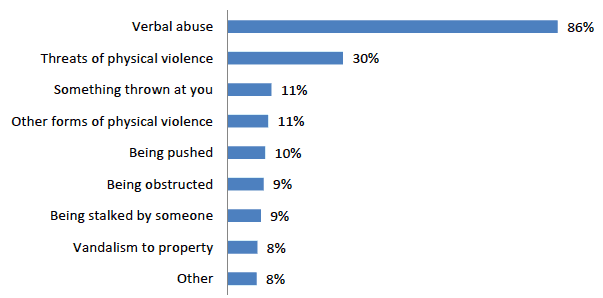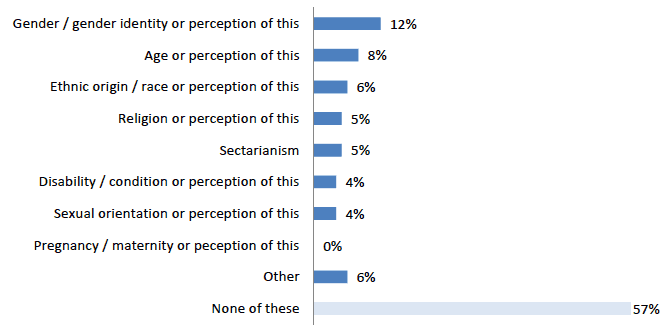Scottish Crime and Justice Survey 2016/17: main findings
This report details the main findings from the Scottish Crime and Justice Survey conducted 2016-2017.
This document is part of a collection
8.2 Focus on harassment and discrimination
The following section presents national level findings on experiences of harassment and discrimination. In line with the general SCJS reporting structure agreed with SCJS users, these results are not broken down within the report for population sub-groups as these findings are based on questions asked to one-quarter of the overall sample. However, these results broken down by demographic and area characteristics are provided in the 2016/17 SCJS data tables.
How common were experiences of harassment in Scotland in 2016/17?
Most adults did not experience any form of harassing or intimidating behaviour in 2016/17.
The SCJS also asked respondents whether they had experienced any incidents in which they were insulted, pestered or intimidated in any way (in person or some other means [94] ) by someone outwith their household in the year prior to interview [95] .
In 2016/17 such experiences were reported by 14% of adults, up significantly from 9% in 2014/15 but similar to the proportion of respondents who were victims of such incidents in 2008/09 (14%).
What can the SCJS tell us about the nature of harassment experienced?
Experiences of harassment in 2016/17 generally took place in person, with verbal threats the most common behaviour encountered.
Looking at details provided by victims on their experience of harassment in 2016/17 (n=190) reveals that:
- the vast majority (88%) encountered some sort of issue 'in person', whilst only 15% reported that they were insulted, pestered or intimidated in writing 'via text, e-mail, messenger or posts on social media'. This suggests that electronic communication does play a role in a proportion of harassment incidents, although 'offline' experiences remain much more common [96] .
- most claimed to have experienced harassing behaviour on more than one occasion over the year with only one-in-four victims (24%) reporting only one incident. Notably, a similar proportion (24%) reported experiencing harassing behaviour on more than ten occasions or too many times to remember in the previous year.
- verbal abuse was the most common type of harassment experienced in 2016/17 – reported by 86% of victims. Other types of harassment, particularly those involving physical contact, were much less commonly experienced - each form of behaviour suffered by around one-in-ten victims as shown in Figure 8.1 [97] .
Figure 8.1: Proportion of harassment victims experiencing different kinds of behaviour in previous 12 months

Base: All respondents who had been insulted, pestered or intimidated in previous 12 months (190); Variable: QHWHAT2
Most experiences of harassment were not perceived to have any particular motivating factor.
In order to explore whether incidents may have been related to discrimination, respondents who experienced harassment in 2016/17 were asked whether they thought any particular (perceived or actual) characteristic they hold may motivated the offender in any encounters. The proportions citing a range of possible reasons are outlined in Figure 8.2.
It shows that just under one-in-eight victims of harassment (12%) thought that their gender, gender identity or perception of this was a possible motivating factor – the most commonly suggested influence. However, the apparent increase in respondents believing this was a reason from 6% in 2014/15 is not statistically significant. More than half of harassment victims in 2016/17 (57%) did not think any of their characteristics were an influencing factor [98] in their encounters.
Regardless of whether they had experienced harassment in 2016/17 or not, the overwhelming majority of respondents [99] claimed they were not worried about being insulted, pestered or intimidated on the basis of a range of potential characteristics which could be motivating factors.
Figure 8.2: What respondents thought any experiences of harassment in last year were or may have been motivated by

Base: All respondents who had been insulted, pestered or intimidated in previous 12 months (190). Variable: QHDISCRIM2
Contact
There is a problem
Thanks for your feedback